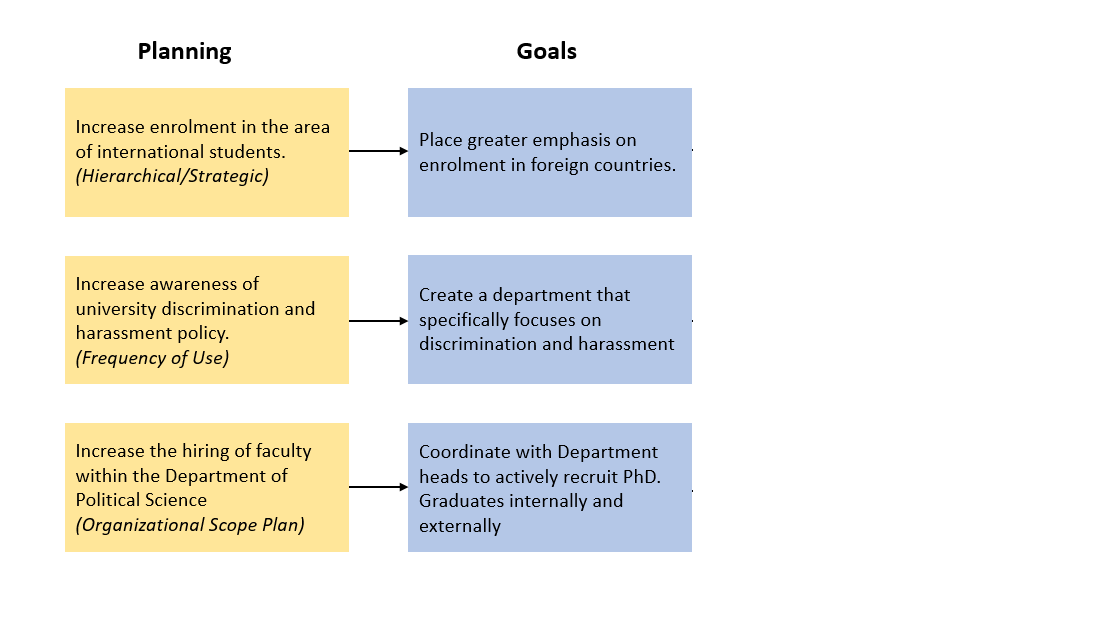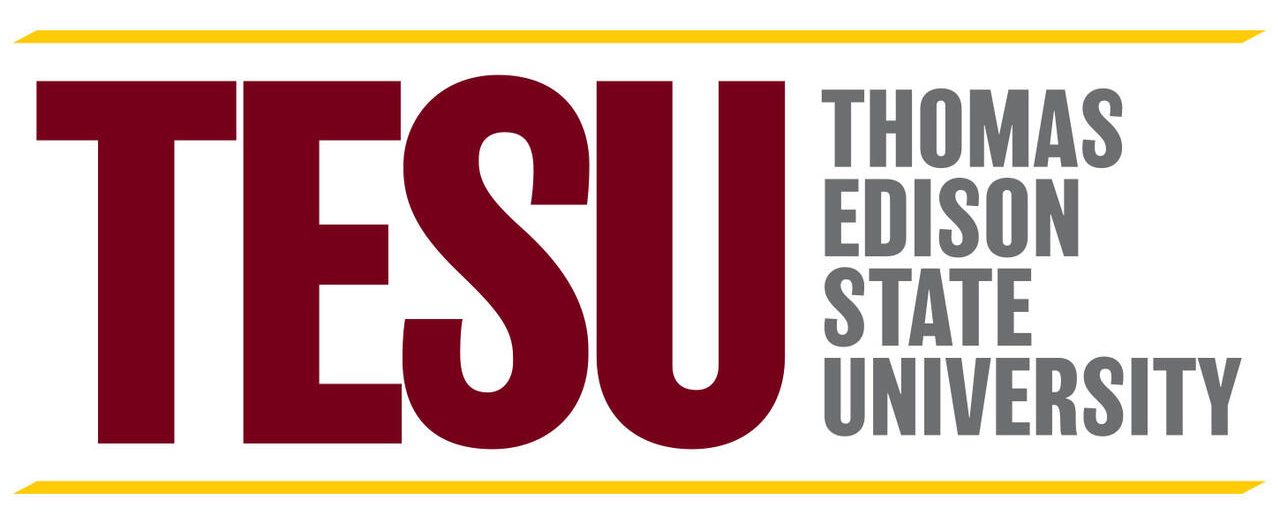2.10 Roles of a Leader
When looking at leadership styles, there is a macro, almost philosophical approach to leadership. Essentially, leaders might tie their leadership style to their own world-views. However, looking deeper into what is actually required to be leader, focusing on the micro details on what a leader can do on a systems’ basis is important. Three areas have been outlined in which leaders should be efficient in creating. The roles of a leader are to create:
- Plans
- Goals
- Timelines
Planning is the act of creating an outline to guide operations in a direction of the organizations’ mission, vision, and values. Within groups, many plans can be devised to get a company to its desired goals. Planning within a corporation is integral to its success, but planning should be dynamic and dependent on the institution’s structure. Within establishments, there are six planning styles: hierarchical plans, strategic plans, frequency-of-use plans, time-frame plans, organizational-scope plans, and contingency plans.[1]
| Hierarchical plans | Strategic plans | Frequency-of-use plans | Time-frame plans | Organizational scope plans | Contingency plans |
|---|---|---|---|---|---|
| Administrative Plans: allocation of resourcesOperating Plans: day-to-day operations | Long term vision for the organization: reason for doing what you are doingConnection to Hierarchy: adhering to the mission, vision, and values | Standing Plan: company policies, rules and proceduresSingle-use plan: Programs, Projects, Budgets | Short: several hours to 1 yearMedium: 1-5 years
Long-Range: More than 5 years |
Whole Organization: Scope is on complete organization (i.e. the whole University)Subsets within organization: Scope is on one area or department (i.e. Admissions and Enrollment) | Alternative Courses: Foreseen disruptions to the plan (i.e. budgetary restrictionsBeing prepared: for actions out of your control (i.e. downturn in the market, natural disaster) |
Figure 2: Types of Organizational Plans. (Source: Copyright Rice University, OpenStax, under CC-BY 4.0 license)
Figure 3 shows some potential plans within learning organizations in relation to the planning styles.

Once the plans are created, the leader must decide what to do within the plans to reach the level desired. After planning comes creating goals or official goals which is described as an organization’s general aims as expressed in public statements.[2] For example, using an institute of higher learning, might have a plan to be on the same level of increased enrollment as other institutions within the province or state. Therefore, the goal associated with this plan would be to increase out-of-province or out-of-state enrollment, perhaps even increasing international enrollment. This is one measure that uses goals to match the plan desired within the university.

After creating the goal, the next phase is to develop a timeline for the goal. A timeline[3] is a given set time to complete a task in order to be successful. To be a smart and effective time manager with goals, the dates must be realistic and achievable. Essentially, using the example of the university, the meeting in July 2019, and the goal is to increase enrollment by September 2019. That does not offer enough time for success. In many cases, it would instead cause more organizational problems. The timelines for goals must work well within plans, and be feasible to all members involved.

Leadership Roles Shaped Through Leadership Characteristics
The roles within leadership through planning, goal creation, and timelines come from a framework of leadership characteristics. Leadership characteristics are specific traits within one leadership style which are used to plan projects and achieve goals. There are four characteristics that are important to the world of organizational leadership:
- Transformational
- Transactional
- Visionary
- Charismatic
Transformational leadership can be compared to a butterfly and the change the butterfly and the metamorphosis it goes through from chrysalis to butterfly. Transformational leadership heightens aspirations, shifts people and organizations to new levels.[4] This is in ctransactional leadershipontrast to transactional leadership or the action of changing styles, adjusting tasks, and allocating rewards to achieve a positive influence.[5] Scholars in the past have compared the different styles before, creating a dichotomy where only one fits. Another way to look at the concepts of transformational and transactional leadership is that they can both be required depending on the context or situation within the organization. Based on the characteristic, it must be done in a framework of emotional intelligence. Goleman describes emotional intelligence as the “ability to manage ourselves and our relationships effectively”.[6] Therefore, when using a transactional approach or a transformational approach, it must be used in the structure of high motivation, high self-awareness, and high social awareness.
As transformational leaders heighten aspirations, visionary leaders heighten aspirations through emotional and intellectual attractions to the leader’s ‘what-can-be’ vision.[7] Through this vision, an organization can build upon it. One example would be a university president wanting her university to be the forefront of cancer research. Perhaps that is a goal five, maybe ten years down the road, but a truly visionary leader would never lose sight of that vision in order to find success.
Charismatic leadership is the ability to use charisma (compelling and inspirational charm) to influence members within an organization to bring about change or implement processes. Charismatic leadership closely mirrors the tenants of transformational leadership as the charismatic actions of an individual can greatly influence change within an organization. Max Weber describes charismatic leaders as ones who possess legitimate power which arises from “exceptional sanctity, heroism, or exemplary character”.[8] Charasmatic leaders can be seen as positive or negative influences on a company. These two individuals presented can show positive and negative influences:
- Positive: Lee Iacocca – saved thousands of jobs during an economic downturn.
- Negative: David Koresh – led men, women, and children to their death during the Waco massacre.
Regardless of the charismatic leader, charisma must be used within the confines of morality, ethics, and agreed upon organizational procedures. In chapter five, a deeper look into ethics and its meaning within organizational structures will be examined.
Path-Goal and Leader-Member Theories
A large portion of leaders direct a path and clarify paths for members in their organization. This is called path-goal leadership, which followers can achieve both task-related and personal goals through directive, supportive, achievement-oriented, and participative leadership. On the other hand there is the leader-member exchange theory of leadership where not everyone is treated the same by the leader creating in groups, and out groups. A middle ground would be to display emotional intelligence within groups to effectively manage relationships in the organization, depending on the characteristics.
Review Questions:
- What is planning and what are the six types of planning styles?
- What are the reasons for goals to exist in organizations?
- What is the difference between transformative and transactional leadership?
Note on Attribution
Chapter 2.10 Roles of a Leader was adapted from “Chapter 3.2, Roles of a Leader – Leadership and Management in Learning Organizations” by Clayton Smith, Carson Babich, and Mark Lubrick, licensed under CC BY-NC-SA 4.0.
- Openstax, Principles of Management (2019, May 31). Retrieved from https://cnx.org/contents/w6yyq31c@8.84:aA5GEBzM@5/17-3-Types-of-Plans ↵
- Ibid. ↵
- A given, set time to complete a task in order to be successful. ↵
- Judge, T. A., & Bono, J. E. (2000). Five-factor model of personality and transformational leadership. Journal of Applied Psychology 85(5), 751-765. https://psycnet.apa.org/fulltext/2000-03966-007.pdf ↵
- Ibid. ↵
- Goleman, D. (1998). Working with emotional intelligence. Bantam Books ↵
- Openstax, Principles of Management (2019, May 31). https://cnx.org/contents/w6yyq31c@8.84:QjpSSVUM@6/13-8-Transformational-Visionary-and-Charismatic-Leadership ↵
- Ibid. ↵
Specific traits within one leadership style in which they plan projects and achieve goals.
A leadership style that heightens aspirations and shifts people and organizations to new levels.
A leadership style that changes styles, adjusts tasks, and allocates rewards to achieve a positive influence.
Goleman’s definition is the ability to “manage ourselves and our relationships effectively”
A leader who heightens aspirations through emotional and intellectual attractions.
A leader who uses charisma to influence members within an organization to bring about change.

